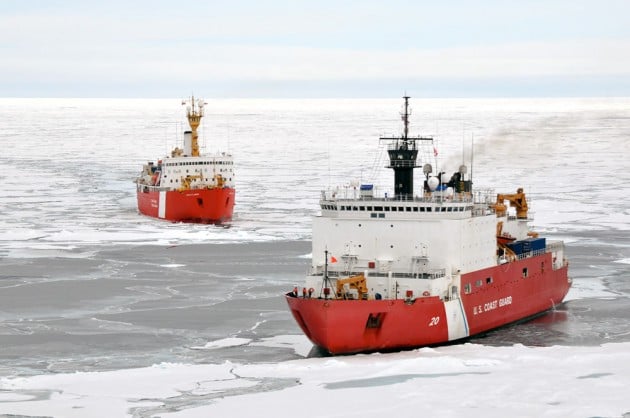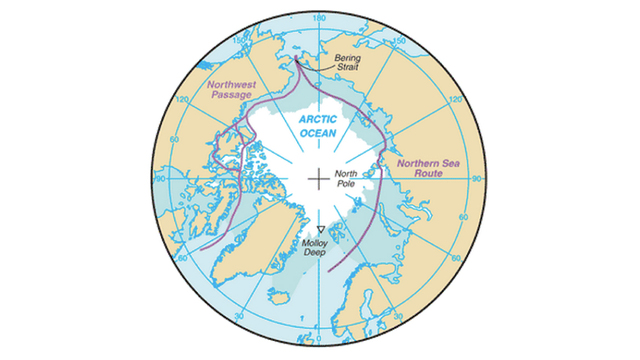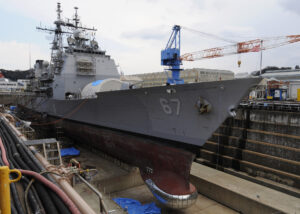
Coast Guard icebreaker Polar Star
WASHINGTON: The Commandant of the Coast Guard is “very confident” US shipyards can build the country’s first icebreaker in 20 years for less than the standard eye-watering $1 billion estimate.
Adm. Paul Zukunft dismissed the idea of cutting costs by buying abroad, a toxic concept for Congress. And he publicly pondered a National Academy of Sciences proposal to economize by building four heavy icebreakers instead of the current plan for three heavies and three mediums.

Adm. Paul Zukunft
“I am very confident we will drive the initial acquisition cost of this platform south of a billion dollars,” Zukunft said this morning at the Center for Strategic & International Studies. “Make no mistake: This will be built in the United States with US parts… That signal’s been sent loud and clear.”
“The real costs are what it takes to stand up this capability in the first place,” Zukunft said. He’s referring to the cost to shipyards of retooling and retraining to handle such heavy-duty work, like bending two-inch thick pieces of steel. Five US yards have been awarded contracts to do industry studies that are progressing “ahead of the curve,” he said.
“Our shipyards have not been building ships of this design in 40 years,” Zukunft noted — the last heavy icebreaker, Polar Star, was commissioned in 1976 – “but I can demonstrate to industry that this is a worthwhile investment, not to build one ship, but to build a fleet of ships.”

A Canadian Coast Guard vessel rendezvous with US Coast Guard icebreaker Healy (foreground) in the Arctic.
Mixed Fleet Or Homogenously Heavy?
The open question is what that fleet will look like. The current plan would build two classes in two phases. Work on three heavy icebreakers would start first, with the initial $1 billion ship entering service by 2023 to replace the geriatric Polar Star, which is already a decade past its original service life and “living on borrowed time,” in Zukunft’s words. Then the nation would build three smaller and supposedly cheaper medium icebreakers. They would serve alongside and ultimately replace the relatively healthy Healy, commissioned in 1999.
The problem with this approach is the first ship in a class is always the most expensive, and building both heavies and mediums means paying that start-up premium twice. When Congress chartered the National Academy of Sciences to study the plan, the NAS team calculated it would be more cost-effective to just keep building heavies.
NAS thought the $1 billion cost estimate for the first heavy icebreaker was pretty solid. They estimated $983 million for the first heavy, falling to $692 for a fourth, for an average of $791 million. But NAS thought the estimate for the mediums was overly optimistic. They calculated that the first medium would cost $786 million – almost $100 million more than just building a fourth heavy.
So can the Coast Guard get by with fewer, more capable icebreakers, with four heavies and no mediums instead of three and three?
“Our rationale behind six (is), if you need one of anything permanently present in on a region, you probably have one in an overhaul and one in a (training) workup and one on station,” Zukunft said, citing similar Navy practices. “It takes three to make one.” If you built four heavies and no mediums, while keeping Healy in service, he went on, you’d have five.

That’s not quite enough to maintain a continuous presence at both the north and south poles. But do you need to? The Arctic Ocean faces increasing international competition – including probing Chinese icebreakers and armed Russian ones – over newly opened trade routes, fisheries, oil, gas, and minerals. Antarctica, by contrast, is a land mass, the world’s largest desert, and it will remain an appalling desolation even with global warming. Arguably, you don’t need year-round icebreakers, just a seasonal presence to open a path to McMurdo research station in the winter.
“One heavy icebreaker servicing the Antarctic provides for the McMurdo breakout and international treaty verification,” the study says. “If the single vessel dedicated to the Antarctic is rendered inoperable, USCG could redirect an icebreaker from the Arctic, or it could rely on support from other nations. The committee considers both options to be viable and believes it difficult to justify a standby (fifth) vessel for the Antarctic mission when the total acquisition and lifetime operating costs of a single icebreaker are projected to exceed $1.6 billion.”

USS Shiloh, a Navy Aegis cruiser, in drydock for a maintenance “availability.”
That’s a big figure – and it’s based on the National Academies’ assumption that new icebreakers would be more efficient and cheaper to operate than the aging Polar Star and even Healy. Having a homogeneous fleet of heavy icebreakers, NAS added, would be cheaper to maintain and operate than a mixed fleet of heavies and mediums. NAS also thought they could shave about $100 million from the production cost of each heavy icebreaker by such economies as eschewing military-specification (MILSPEC) parts in favor of commercial off-the-shelf (COTS) ones, as is common practice abroad.
Zukunft is clearly nodding along with at least part of the NAS study. ”If you build three heavies and say you’re done, then switch to medium, the lead ship of new class – the first medium — will probably cost more than a heavy,” he said. While he didn’t comment on a fleet of four heavies and no mediums, he did say a hypothetical fleet of six heavies “gives you many more options.”
Last year, Zukunft noted, Healy had to make an unplanned detour south to medevac a crewmember. It took the medium icebreaker about 36 hours to smash through; a heavy would have made in eight or nine hours, he said. Clearly he’s aware of the attractions of an all-heavy fleet.
That said, Zukunft made clear he’s focusing on that first ship, not on whatever may come after. “ I need that first one in the water by 2023,” before the Polar Star conks out, said Zukunft. He’s very glad there’s a joint Coast Guard-Navy program office with $150 million in the budget, but “$150 million buys me about 20 percent of an icebreaker. I need to get this first one fully funded.”
Sullivan: Defense industry ‘still underestimating’ global need for munitions
National Security Advisor Jake Sullivan said that there are “no plans” for another Ukraine supplemental at this point.


























